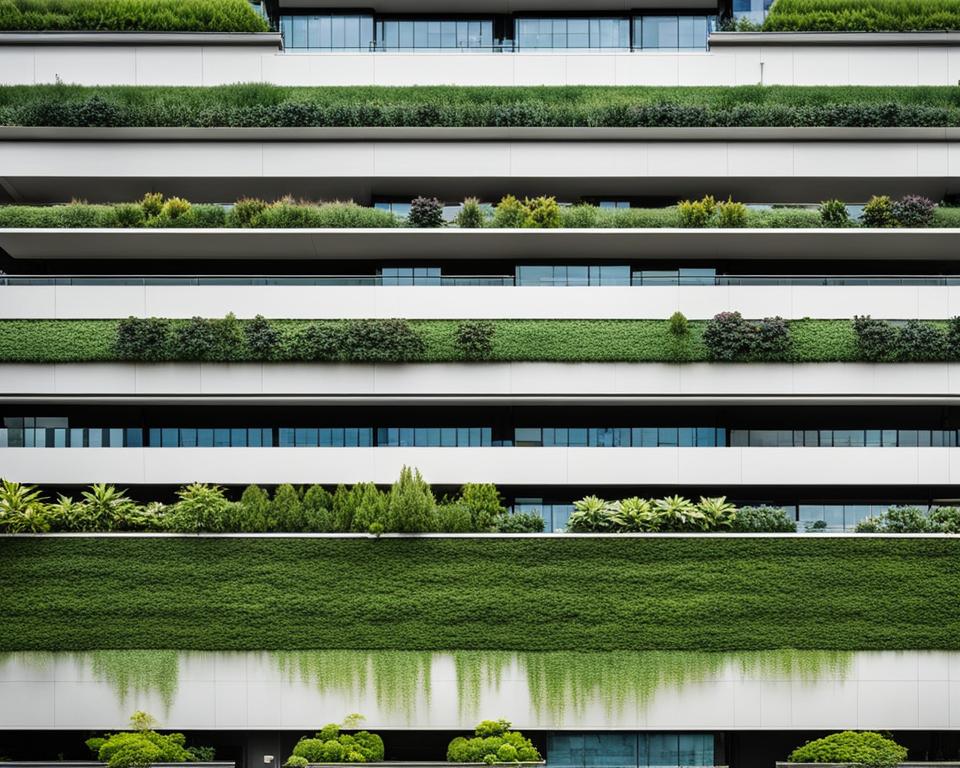Imagine transforming your business’s limited outdoor and indoor spaces into thriving green areas. With commercial vertical gardening systems, this vision is not just possible; it’s a flourishing reality embraced across urban landscapes like Baton Rouge and beyond. These innovative systems allow you to ascend beyond the horizontal limitations and delve into the realm of vertical growth, introducing a fresh dimension of urban farming technologies.
Commercial green walls and commercial vertical farming techniques are redefining how we think about cultivation in dense city environments. You’ll discover that these aren’t just sustainable gardening solutions; they are a testament to human ingenuity, making efficient use of every square inch available. Prepare to explore how vertical gardens are enhancing both the aesthetic and ecological dynamics of urban centers.
Key Takeaways
- Commercial vertical gardening systems are a testament to maximizing urban space and agricultural efficiency.
- These systems leverage vertical real estate, making them perfect for urban areas like Baton Rouge with space constraints.
- Breathing life into urban centers, commercial green walls not only boost space utilization but also contribute to sustainability.
- Vertical farming technologies are adaptable to a range of plants, from houseplants to vegetables, enhancing biodiversity in cities.
- Equipping a commercial setting with a vertical garden simplifies maintenance tasks like weeding, thanks to accessible garden bed heights.
- Sustainable gardening solutions such as vertical farming promote a more eco-friendly approach to city living and working spaces.
An Introduction to Vertical Gardening in Urban Landscapes
As cities continue to expand vertically, innovative urban farming technologies are revolutionizing the concept of gardening in densely populated areas. Baton Rouge, like many urban landscapes, has embraced the transformative approach of vertical gardening, finding solutions in the vertical plane–an essential strategy in spaces that traditional horizontal farming cannot accommodate. This practice isn’t just a trend, it’s a response to the pressing needs of urban sustainability.
The Rise of Urban Farming Technologies
The surge in urban farming technologies has been pivotal in introducing smart vertical gardening solutions into urban centers. It is becoming increasingly clear that effective food production can take place in unconventional spaces. Incorporating indoor vertical gardens into the architectural design of buildings is not only aesthetically pleasing but also serves as a functional strategy for food production and environmental improvement.
Benefits of Commercial Vertical Gardening in City Environments
Commercial vertical gardening presents numerous advantages for city environments, paramount being the efficient utilization of limited urban space. Here’s a look at some key benefits:
- Maximizes limited space by expanding gardens upward rather than outward.
- Supports biodiversity by enabling a variety of plant species to flourish in a single vertical setup.
- Enhances air quality by purifying urban air, a significant benefit for metropolitan health and well-being.
- Fosters community engagement and educates urban residents about the importance of sustainability and local food production.
Vertical gardening in urban environments also brings forth an innovative way to repurpose existing structures. What was once unused wall space can now be transformed into lush, green oases, contributing not only to urban beautification but also to the sustainability of the ecosystem.
| Feature | Benefit |
|---|---|
| Space-Efficiency | Creates more green space without expanding the building’s footprint. |
| Plant Diversity | Accommodates various plants from herbs to small vegetables, promoting biodiversity. |
| Air Purification | Contributes to improved air quality by filtering pollutants and releasing oxygen. |
| Community Engagement | Encourages local food production and educates on sustainable practices. |
In implementing these smart vertical gardening solutions, cities like Baton Rouge become pioneers in the creation of sustainable urban landscapes. As more technologies develop, the integration of greenery into everyday city life becomes not just a vision but a tangible reality, positioning indoor vertical gardens at the heart of urban planning.
Commercial Vertical Gardening Systems: Space-Efficient Farming
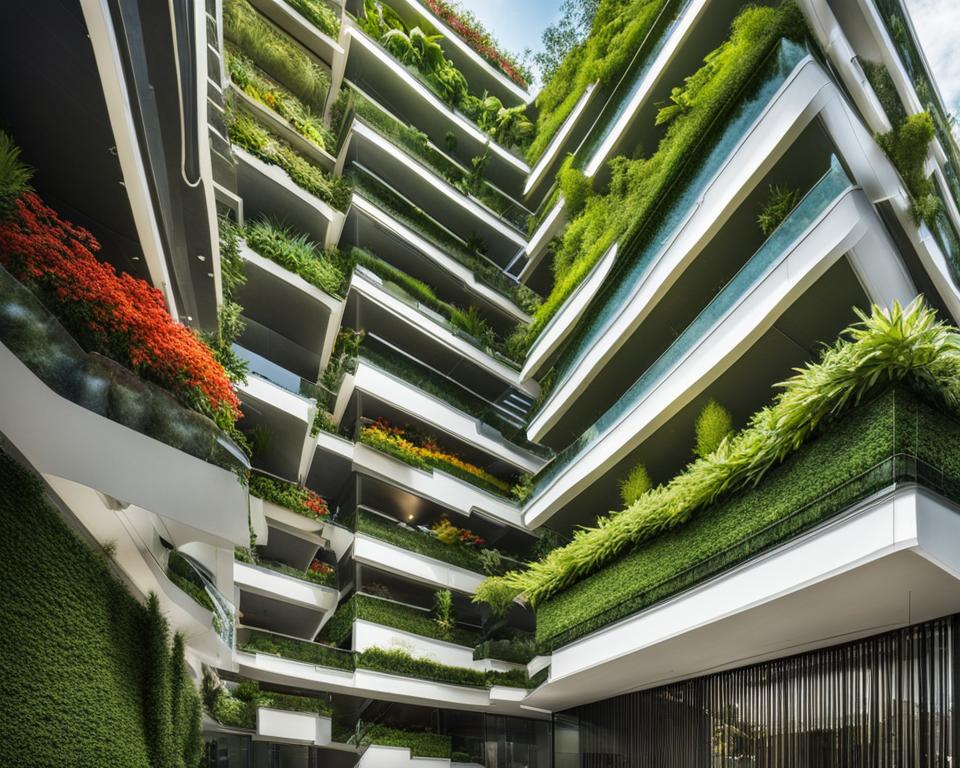
As urban landscapes continue to expand, commercial vertical gardening systems are revolutionizing the concept of agriculture in dense environments. Utilizing advanced commercial vertical gardening equipment, these systems enable the growth of crops in a fraction of the space traditionally required for farming. Offering sustainable gardening solutions, vertical farms provide an answer to the diminishing ratio of arable land per person, making them a vital feature in the future of urban agriculture.
The beauty of commercial vertical gardening systems lies in their versatility, allowing the installation in a variety of repurposed spaces. From decommissioned factories to bustling shopping centers, there are endless possibilities for integrating productive green spaces. These systems do more than just beautify urban areas; they generate a significant yield of crops, leveraging techniques like hydroponics and aeroponics to use water and nutrients more efficiently.
For those interested in developing such systems, it’s essential to understand the types of commercial vertical gardening equipment at the cornerstone of this innovative practice. The following comparative table outlines some common equipment used in vertical farming, highlighting their roles and benefits within the larger context of sustainable gardening solutions.
| Equipment Type | Primary Use | Benefits |
|---|---|---|
| Hydroponic Towers | Maximizing plant density | Space efficiency, reduced water usage |
| Aeroponic Systems | Nutrient mist application | Enhanced nutrient absorption, minimal water waste |
| Grow Lights | Artificial light provision | Controlled growth, year-round production |
| Monitoring Sensors | Environmental control and data collection | Optimized growing conditions, data-driven decisions |
Employing these tools, vertical farming transforms underutilized spaces into lush, productive landscapes. Yet, it’s not just about generating food; it’s also about fostering a sustainable lifestyle and community connection. Encouraging local production, commercial vertical gardening systems reduce transportation emissions, promote fresher produce, and pave the way towards a greener economy and healthier society.
In your endeavor to embrace vertical farming, consider how each piece of commercial vertical gardening equipment can be tailored to suit your particular agricultural needs, optimizing space and resources for a bountiful and sustainable harvest.
Indoor Vertical Gardens: Bringing Agriculture into the Concrete Jungle
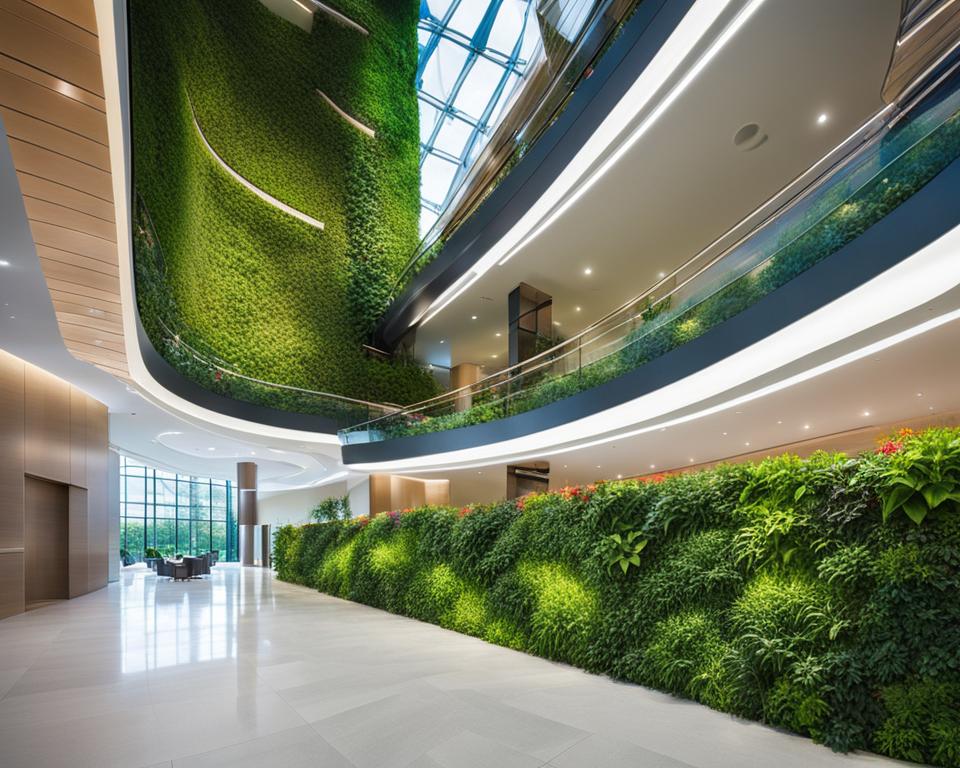
As city skylines grow increasingly dense, the innovative concept of indoor vertical gardens has emerged as a beacon of sustainability, weaving nature into the fabric of urban living. These gardens represent more than mere decoration; they’re a testament to how vertical farming systems have evolved, turning underutilized spaces into bastions of greenery and growth. By leveraging vertical space, urban dwellers and businesses can indulge in the cultivation of fresh produce without the expansive footprint traditional farming demands.
Amidst concrete and steel, commercial green walls don’t just serve an ornamental purpose; they embody a significant advancement in urban design. These living walls act as the lungs of built environments, purifying air and fostering a connection with nature that’s often lost in metropolitan areas. Furthermore, they exemplify the pinnacle of commercial vertical farming, transforming how we envision agricultural integration into daily life.
Vertically Farmed Produce: A Sustainable Choice
The hallmark of any successful vertical garden is its yield, and indoor vertical gardens are particularly adept at producing a variety of vegetables and herbs. Notably, plants like lettuce thrive in these settings, where the shallow root systems find ample support. The carefully managed ecosystems within these vertical farms allow for a year-round harvest, presenting a viable and sustainable food source that’s both convenient and responsive to the demands of urban sustainability.
Innovative Commercial Green Walls for Urban Areas
Embarking on a journey into vertical cultivation brings about a fusion of aesthetics and functionality with commercial green walls. They are more than just a component of vertical farming systems; they are pioneering fixtures in modern architecture. By reimagining wall spaces as productive green canvases, these structures also contribute to the well-being of residents and workers, infusing serenity into bustling city life.
The transformative impact of indoor vertical gardens and commercial green walls carves a path toward a greener future. It proves that even in the most unlikely places, agriculture can flourish, ensuring that the concrete jungles many call home can sustain vibrant ecosystems that support both people and the planet.
Types of Vertical Farming Systems and Their Components
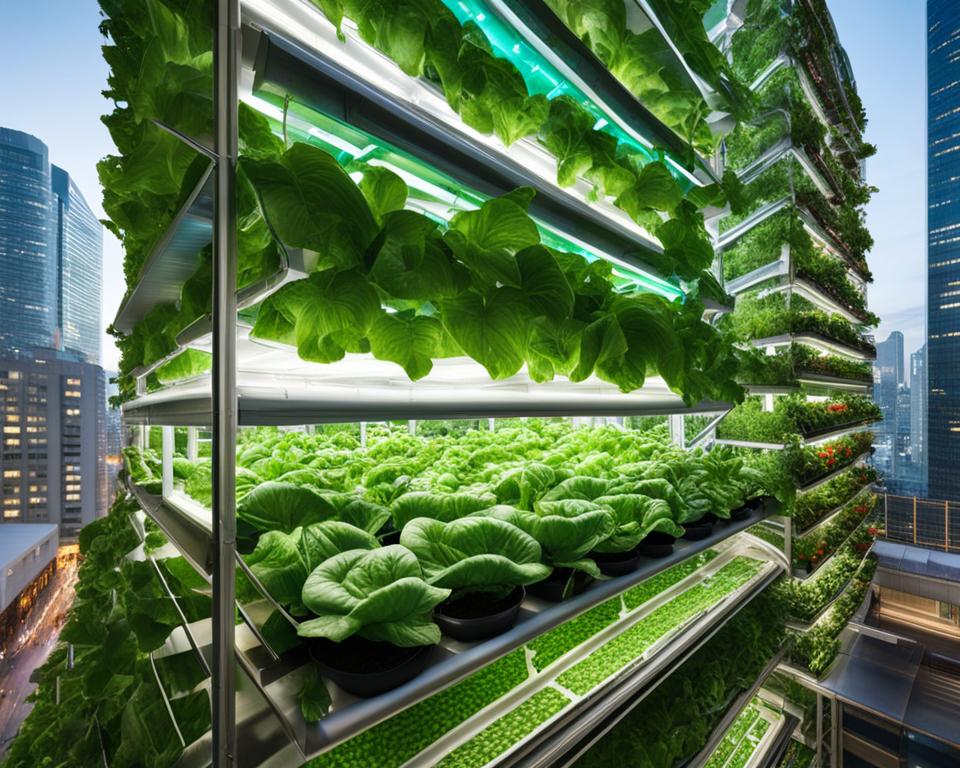
Exploring the diverse world of vertical farming systems reveals a myriad of innovative approaches to agriculture. From the home gardener to the large-scale commercial producer, these systems employ advanced commercial vertical gardening equipment and vertical hydroponic systems to create thriving gardens in the smallest of footprints. Whether you are considering a venture into vertical farming or looking to enhance your current setup, understanding the different types and components is invaluable.
At the more accessible end of the spectrum are wall planters and repurposed gutters, which allow for a straightforward way to grow herbs, flowers, and greens. Transforming underused vertical surfaces into verdant displays, these solutions can turn a bare wall into a lush and productive space. Smart vertical gardening solutions elevate these simple setups with automated watering systems and integrated growth lights.
- Wall Planters: Crafted to attach securely to vertical surfaces and ideal for smaller plants that don’t require deep soil.
- Repurposed Gutters: Utilizing horizontal rows of gutters to create a cascading garden effect, perfect for herbs and strawberries.
Moving towards more sophisticated systems, PVC towers and bottle gardens are engineered to maximize plant density and ease of harvest. These utilize the principles of vertical hydroponic systems, bypassing soil to deliver nutrients directly to the roots of the plants.
- PVC Towers: Comprised of vertical columns with multiple plant sites, these towers circulate nutrient solutions through the central pipe to feed plants.
- Bottle Gardens: Often made from recycled materials, bottle gardens stack plant containers vertically, using gravity to distribute water and nutrients.
As the push for sustainable urban ecosystems grows, these vertical farming systems demonstrate that the sky truly is the limit when it comes to innovative and ecologically sound agricultural practices.
Maximizing Yield with Vertical Hydroponic Systems
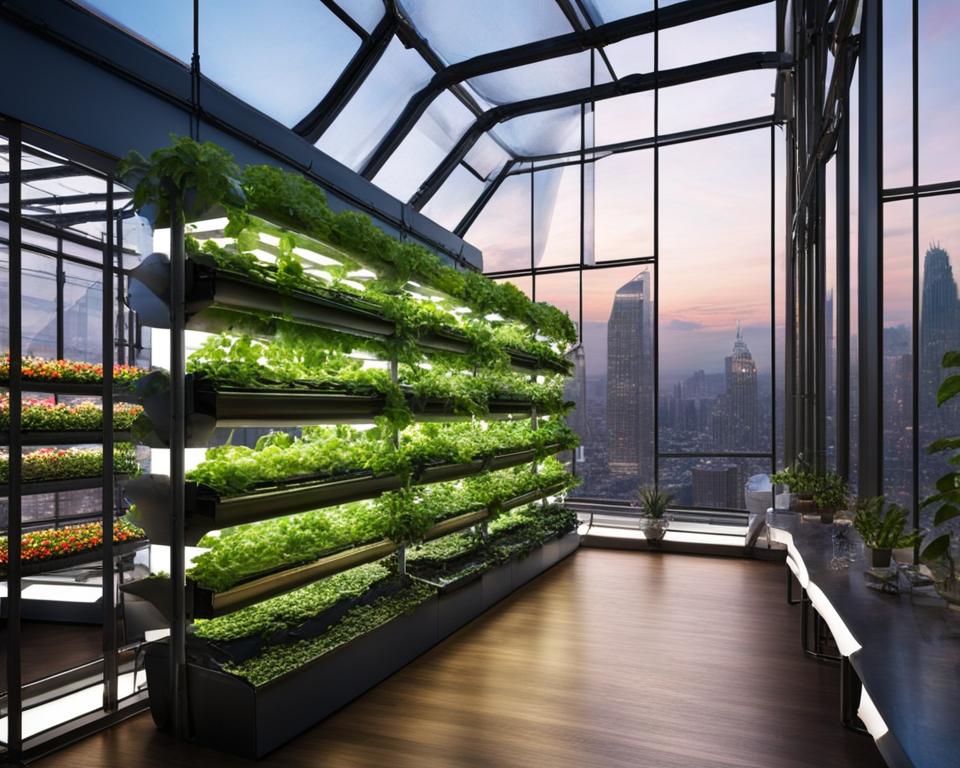
In the thriving world of commercial vertical farming, the adoption of vertical hydroponic systems has marked a significant progression towards enhancing agricultural yield and sustainability. These innovative systems have redefined the concept of farming in urban settings by utilizing minimal space for maximum output, a practice that aligns with the essence of smart vertical gardening solutions.
Imagine a farming technique that does not require soil, is less reliant on water, and provides your plants with a precise cocktail of nutrients directly to their roots. This is what vertical hydroponics brings to the table, seamlessly integrating into urban landscapes that might otherwise be barren of greenery and productivity.
Understanding Hydroponics in Commercial Vertical Farming
Commercial growers are increasingly turning to hydroponics for its ability to produce high-quality crops at a faster rate than traditional farming methods can offer. Hydroponic systems can be placed anywhere, from rooftops to old warehouses, making them a core feature of the sustainable gardening solutions movement.
Water Efficiency and Nutrient Delivery in Hydroponic Gardens
By recirculating water, these systems are incredibly water-efficient, conserving one of our planet’s most precious resources. Moreover, the precise delivery of nutrients directly to plant roots ensures that the plants get exactly what they need for optimal growth, eliminating the guesswork often associated with soil-based gardening.
In conclusion, integrating vertical hydroponic systems into commercial farming practices not only boosts yield but also contributes to the conservation efforts necessary in today’s urban environments. This smart approach to agriculture promises bountiful harvests while maintaining ecological balance, showcasing the pinnacle of sustainable gardening solutions.
Integrating Sustainable Gardening Solutions in Commercial Settings
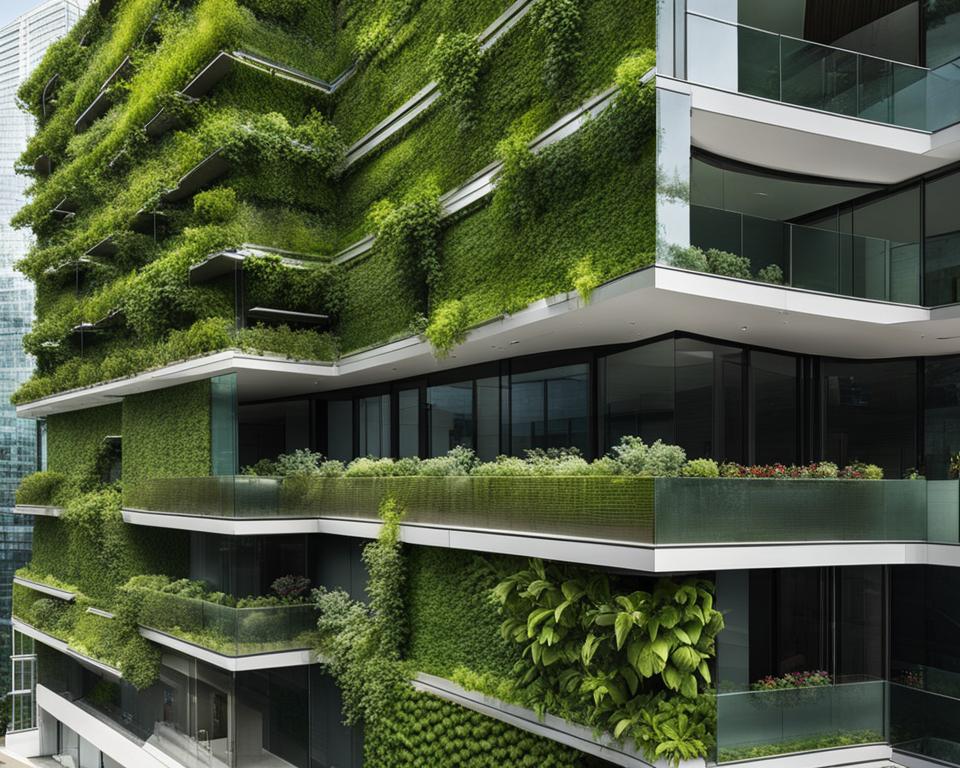
As you venture into the realm of urban sustainability, it’s crucial to recognize the role that sustainable gardening solutions play in enhancing our cityscapes. Commercial vertical gardening systems are at the forefront of this green revolution, seamlessly incorporating lush greenery into the dense urban fabric. By embracing these innovations, commercial entities can provide a swath of environmental benefits while creating pleasant and health-promoting environments.
One of the most striking applications of these systems are the commercial green walls that have become synonymous with eco-friendly architecture. Not only do these living walls present a visually stunning tapestry of foliage, but they also contribute significantly to air purification and noise reduction, creating more livable urban spaces.
The benefits of integrating green walls and vertical farms in commercial areas extend beyond aesthetics and into the broader aims of environmental stewardship and biodiversity promotion:
- Improvement of air quality through natural filtration processes
- Enhancement of biodiversity by providing habitats for pollinators and other wildlife
- Reduction of ambient noise, fostering a more tranquil urban environment
- Thermal insulation, which contributes to energy savings in heating and cooling
To fully grasp the impact of these systems, consider the following comparison:
| Aspect | Traditional Commercial Space | Commercial Space with Vertical Gardening |
|---|---|---|
| Air Quality | Often polluted due to emissions | Naturally purified by plants |
| Biodiversity | Minimum to none | Increased, with habitats for various species |
| Noise Level | High, with urban clamor | Lowered by foliage buffering |
| Energy Efficiency | Lower, without natural insulation | Improved through the insulating properties of plants |
In conclusion, adopting sustainable gardening solutions within commercial settings offers a pathway to greener, more vibrant cities. By installing commercial vertical gardening systems and integrating commercial green walls, businesses can play a pivotal role in fostering urban sustainability, making our cities not only more beautiful but also more eco-conscious and habitable.
Smart Vertical Gardening Solutions for Modern Businesses
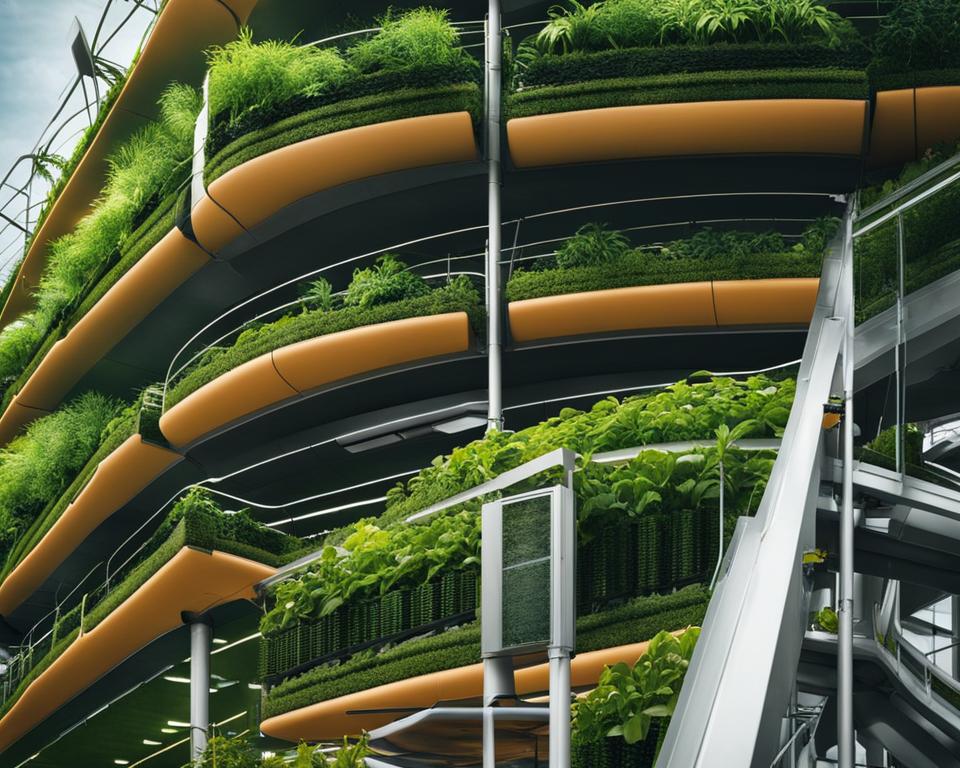
As cities grow denser, modern businesses are now leading the charge in harnessing smart vertical gardening solutions to meet the twin challenges of limited space and the need for high productivity. Forward-thinking enterprises are rapidly adopting these innovative systems to revolutionize urban agriculture. By doing so, they’re not only optimizing valuable urban space but are also contributing to more sustainable and resilient food systems in the heart of our cities.
Automated Vertical Farming: The Future of Urban Agriculture
Imagine a future where your business could grow lush, nutritious produce right in the heart of the concrete jungle. This is the promise of automated vertical farming, which is setting the new standard in urban agriculture. Leveraging the latest in agricultural technology, these systems use minimal resources for maximum yield, perfectly embodying the ethos of smart urban living. The crucial combination of precision and automation ensures crops can be cultivated with utmost efficiency – energy use is streamlined, water is conserved, and every inch of space is effectively utilized.
Commercial Vertical Gardening Equipment: Tools for Optimization
Your venture into vertical agriculture would be incomplete without the proper tools. Commercial vertical gardening equipment is designed to complement the sophisticated needs of these high-tech farming ventures. From intricate irrigation networks to LED lighting tailored to plant growth cycles, this equipment represents the pinnacle of urban farming technologies. These tools are the building blocks of a successful vertical garden, ensuring that every plant receives the precise care it needs to thrive. With the right equipment, scaling up operations becomes a realistic and achievable goal for businesses looking to make a mark in this burgeoning field.
As you consider integrating these dynamic, eco-friendly systems into your business model, bear in mind the wave of innovation they bring. You’re not just adopting new planting techniques; you’re pioneering an urban farming revolution that marries convenience with sustainability. It’s a smart choice for your business, the community, and the planet.
Case Studies: Successful Commercial Vertical Gardening Outcomes
Exploring the practical application of commercial vertical gardening systems, it’s important for you to consider their effectiveness across different environments. Globally, from the congested districts of urban Japan to the vast expanses of New Jersey, these innovative systems have been put to the test—with noteworthy successes.
Vertical hydroponic systems, for instance, have been standout performers in these urban areas. In Japan, they’ve played a pivotal role in revolutionizing small-space gardening, offering a blueprint for mega-cities worldwide. These systems have fostered lush indoor vertical gardens that defy the limitations of traditional farming methods, effectively turning every square inch of available space into productive agricultural real estate.
In New Jersey’s previously unused industrial sites, similar systems were implemented, offering a new life to dormant structures. By repurposing these spaces for vertical farming, not only was there a reduction in pesticide use due to the controlled environments, but the water and nutrient usage became highly efficient—showcasing the potential for sustainability and profitability within the burgeoning field of urban agriculture.
Let’s delve deeper into specific case studies that have set the standard for vertical hydroponic systems and their application in different settings around the globe.
| Location | Type of System | Plants Grown | Water Efficiency | Pesticide Reduction |
|---|---|---|---|---|
| Tokyo, Japan | Hydroponic Tower | Lettuce, Herbs | 90% more efficient than soil | 100% reduction |
| Newark, New Jersey | Aeroponic Vertical Farm | Leafy Greens, Berries | 70% less water than traditional | 95% reduction |
With such compelling results, it’s clear why commercial vertical gardening systems are not just a trend, but a transformative movement towards a greener, more sustainable approach in our urban landscapes.
Conclusion
As urban spaces continue to evolve, commercial vertical gardening systems stand as a beacon of innovation, offering not only a viable option for gardening in the heart of the city but also a critical response to the necessity for sustainable gardening solutions. The ingenuity behind these setups transforms underutilized vertical planes into thriving green canvases, projecting a vision of the future where integration between nature and urban architectures is seamless.
The implications of commercial vertical farming are profound, influencing a multitude of environmental and social factors. Vertical farming systems increase the density of food production, thereby reducing transportation distances and carbon footprints. Meanwhile, commercial green walls contribute to the aesthetic and ecological richness of cityscapes, offering a breath of fresh air quite literally. Further, the introduction of vertical hydroponic systems exemplifies the advancement in agricultural technology, enhancing resource efficiency and crop yields.
Your city’s sky may soon see luscious green instead of the dull gray of concrete, thanks to these ingenious applications. As the globe marches into a future where the reality of limited arable land meets the unchecked momentum of urbanisation, these vertical wonders underscore the resilience of innovation. Indeed, as more communities adopt such methods, our cities will transform into hubs of lush sustainability—productive, livable, and vibrantly green.
FAQ
What are commercial vertical gardening systems, and how do they maximize space?
Commercial vertical gardening systems are innovative structures that allow plants to be grown vertically, rather than horizontally. This approach maximizes space by taking advantage of vertical areas like walls, which is particularly beneficial in urban environments where ground space is limited. These systems can range from simple wall-mounted planters to sophisticated commercial green walls and hydroponic setups. They are essential components of urban farming technologies and sustainable gardening solutions.
How are urban farming technologies changing the landscape of city environments?
Urban farming technologies, such as indoor vertical gardens and smart vertical gardening solutions, are transforming city environments by enabling agricultural activities in spaces where traditional farming is not feasible. They bring farming into urban centers, promoting local food production, reducing the need for transportation, enhancing food security, and contributing to more sustainable urban ecosystems.
What are the benefits of commercial vertical gardening in city environments?
Commercial vertical gardening offers several benefits in city environments, including the efficient use of limited space, improved air quality, increased biodiversity, and the mitigation of heat island effects. It also provides aesthetic benefits that can enhance the wellbeing of urban residents and improve the appearance of commercial and public spaces.
What kind of produce is suitable for indoor vertical gardens?
Indoor vertical gardens are particularly well-suited for growing plants with shallow root systems, such as lettuce, herbs, microgreens, and some varieties of strawberries and tomatoes. These gardens can also support houseplants and decorative foliage, making them versatile for both food production and aesthetic purposes in indoor settings.
What makes commercial green walls innovative in urban areas?
Commercial green walls are innovative in urban areas because they are multi-functional—they improve air quality by filtering pollutants, regulate building temperatures through insulation, reduce noise levels, and provide an attractive green element in otherwise gray landscapes. Furthermore, green walls can be integrated into building design in various ways, contributing to the overall sustainability and enhanced aesthetics of urban spaces.
What types of vertical farming systems are available?
There are various types of vertical farming systems available, ranging from passive systems like the use of trellises and hanging planters to more advanced systems like vertical hydroponic and aeroponic setups. These systems can be customized to suit specific plants and scalability requirements, using commercial vertical gardening equipment tailored to optimize plant growth and productivity.
How do vertical hydroponic systems work in commercial vertical farming?
Vertical hydroponic systems work by circulating a water-based, nutrient-rich solution to plants grown without soil. Plants are supported in a vertical structure allowing roots to have direct access to the solution. These systems can be highly efficient in water usage and can promote faster plant growth by delivering nutrients more effectively, making them ideal for use in commercial vertical farming.
What constitutes smart vertical gardening solutions, and how do they support modern urban agriculture?
Smart vertical gardening solutions typically include the integration of technology into vertical farming, such as automated irrigation systems, climate control, LED grow lights, and sensor-based monitoring of plant health. These advancements support modern urban agriculture by optimizing growing conditions, increasing yields, and reducing labor and resource inputs.
Can you provide examples of successful commercial vertical gardening outcomes?
Successful commercial vertical gardening outcomes can be seen in urban agriculture projects around the world. For instance, some commercial buildings in Japan have integrated vertical farms that produce leafy greens for local consumption. In New Jersey, repurposed warehouses use vertical hydroponic systems to grow crops like lettuce and herbs year-round, demonstrating the potential of indoor vertical gardens to contribute to sustainable urban food systems.

